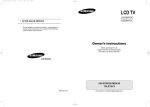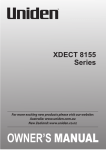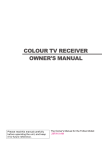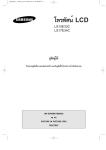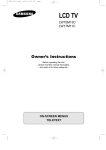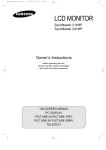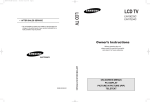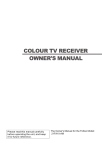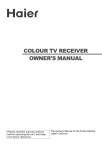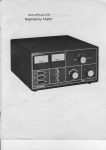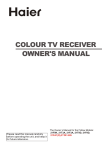Download Samsung LS17E34C User Manual
Transcript
BN68-00438G-01Eng-AS15CO 6/17/03 1:48 PM Page 1 LCD TV LS15E33C LS17E34C Owner’s Instructions Before operating the unit, please read this manual thoroughly, and retain it for future reference. ON-SCREEN MENUS PC DISPLAY PICTURE IN PICTURE (PIP) TELETEXT BN68-00438G-02Eng 8/19/03 9:20 PM Page 2 Caution CAUTION RISK OF ELECTRIC SHOCK DO NOT OPEN CAUTION: TO PREVENT ELECTRICAL SHOCK, DO NOT REMOVE REAR COVER, NO USER SERVICEABLE PARTS INSIDE. REFER SERVICING TO QUALIFIED SERVICE PERSONNEL. WARNING: The lightning flash and arrow head within the triangle is a warning sign alerting you of “dangerous voltage” inside the product. The exclamation point within the triangle is a warning sign alerting you of important instructions accompanying the product. TO PREVENT DAMAGE WHICH MAY RESULT IN FIRE OR SHOCK HAZARD, DO NOT EXPOSE THIS APPLIANCE TO RAIN OR MOISTURE. ☛ The main voltage is indicated on the rear of your set and the frequency is 50 or 60 Hz. Information in this document is subject to change without notice. © 2003 Samsung Electronics Co., Ltd. All rights reserved. Reproduction in any manner whatsoever without the written permission of Samsung Electronics Co., Ltd. is strictly forbidden. Samsung Electronics Co., Ltd. shall not be liable for errors contained herein or for incidental or consequential damages in connection with the furnishing, performance, or use of this material. The Samsung logo is the registered trademarks of Samsung Electronics Co., Ltd.; Microsoft, Windows® and Windows® NT are registered trademark of Microsoft Corporation; VESA, DPMS and DDC are registered trademarks of Video Electronics Standard Association. All other product names mentioned herein may be the trademarks or registered trademarks of their respective owners. TRADEMARK & LABEL LICENSE NOTICE Manufactured under license from Dolby Laboratories. “Dolby”, “Pro Logic”, and the double-D symbol are trademarks of Dolby Laboratories. English-2 BN68-00438G-02Eng 10/6/03 8:12 AM Page 3 Safety Instructions These illustrations represent precautions concerning your TV. 75% 10% 35` H H 5` œ Do not expose the TV to extreme temperature conditions or to extreme humidity conditions. Do not expose the TV to direct √ sunlight. œ Do not expose the TV to any liquids. If the TV is broken, do not try to √ repair it yourself. Contact qualified service personnel. œ During a storm conditions (especially when there is lightning) unplug the TV from the mains socket and aerial. Keep all power adaptors apart. √ Possible fire hazard. œ Always keep the power adaptor in a well-ventilated area. Remove and discard the plastic √ cover from the power adaptor before use. Possible fire hazard. œ Keep the power adaptor away from any other heater. Possible fire hazard. If the remote control is not used for a long √ period of time, remove the batteries and store it in a cool, dry place. THIS DEVICE IS NOT FOR USE IN INDUSTRIAL ENVIRONMENTS Please use a soft and dry cloth (not containing volatile matter) when you clean the TV. English-3 BN68-00438G-01Eng-AS15CO 6/17/03 1:48 PM Page 4 Contents (continued) ◆ FOREWORD ■ ■ Caution .......................................................................................................... Safety Instructions .......................................................................................... 2 3 ◆ CONNECTING AND PREPARING YOUR TV/Monitor ■ ■ ■ ■ ■ ■ ■ ■ ■ Viewing the Control Panel ............................................................................. Viewing the Connection Panel ....................................................................... - Connecting an Aerial or Cable Television Network .................................... - Connecting DVD, VCR, or DTV Set-Top Box.............................................. - Connecting Computer................................................................................. - Connecting External A/V Devices ............................................................... - Kensington Slot ........................................................................................... Viewing Pictures From External Sources......................................................... Inserting the Batteries in the Remote Control.................................................. Viewing the Remote Control (All Functions Except Teletext) .......................... Viewing the Remote Control (Teletext Functions)........................................... Switching On and Off .................................................................................... Placing in Standby Mode ............................................................................... Becoming Familiar with the Remote Control.................................................. ◆ SETTING ■ ■ ■ ■ ■ ■ ◆ USING ■ ■ ■ ■ English-4 THE 6 7 8 8 8 9 9 10 11 12 13 14 14 15 CHANNELS Storing Channels Automatically...................................................................... Sorting the Stored Channels ........................................................................... Storing Channels Manually............................................................................. Giving Channels Names................................................................................. Skipping Unwanted Channels ........................................................................ Fine Tuning Channel Reception ..................................................................... 16 17 18 20 21 21 THE VARIOUS FUNCTIONS (continued) Changing the Picture Standard ....................................................................... Adjusting the Picture Settings ......................................................................... Selecting the Picture Format........................................................................... Freezing the Current Picture........................................................................... 22 22 23 23 BN68-00438G-01Eng-AS15CO 6/17/03 1:48 PM Page 5 Contents ◆ USING ■ ■ ■ ■ ■ ■ ■ ◆ USING ■ ■ ■ ■ ■ ■ ■ ◆ USING ■ ■ ■ ■ ■ THE VARIOUS FUNCTIONS Changing the Sound Standard ........................................................................ Adjusting the Sound Settings .......................................................................... Enjoying the Dolby Sound.............................................................................. Selecting the Sound Mode.............................................................................. Viewing the Picture In Picture (PIP)................................................................ Switching Off Automatically........................................................................... Displaying Information................................................................................... THE PC FUNCTIONS Setting up Your PC Softerware (Based on Windows 2000) ............................. Adjusting the Brightness and Contrast ............................................................ Adjusting the Image Quality........................................................................... Changing the Image Position.......................................................................... Adjusting the Color ........................................................................................ Initializing the Image Settings......................................................................... Adjusting the PC Screen Automatically .......................................................... THE 24 24 25 25 26 27 27 28 29 30 31 32 33 33 TELETEXT FEATURE Teletext Feature.............................................................................................. Displaying the Teletext Information................................................................ Selecting a Page by Number .......................................................................... Using FLOF to Select a Page .......................................................................... Storing Teletext Pages..................................................................................... 34 35 36 37 37 ◆ RECOMMENDATIONS FOR USE ■ ■ ■ ■ ■ ■ ■ Troubleshooting: Before Contacting Service Personnel................................... Power Saver ................................................................................................... Technical and Environmental Specifications .................................................. Display Modes ............................................................................................... Maintenance of Your Telelvision.................................................................... How to assemble the TV set and stand base................................................... Installing the Wall Mount Kit.......................................................................... Symbols Press ☛ ➢ Important Note 38 39 40 41 42 43 44 English-5 BN68-00438G-01Eng-AS15CO 6/17/03 1:48 PM Page 6 Viewing the Control Panel TV/VIDEO Displays a menu of all of the available input sources. (TV - Video - S-Video - Component - PC) MENU Opens the on-screen menu. - VOL + Moves the selector left or right on the OSD. Increases or decreases the level of audio volume and the values of the selected function. CH Moves the selector up or down on the OSD. Increases or decreases the channel number. English-6 POWER Turns ON/OFF your set. SPEAKER POWER INDICATOR Lights up when you turn the power off. REMOTE CONTROL SENSOR BN68-00438G-01Eng-AS15CO 6/17/03 1:48 PM Page 7 Viewing the Connection Panel (continued) Option Power Input ☛ Whenever you connect an audio or video system to your set, ensure that all elements are switched off. Refer to the documentation supplied with your equipment for detailed connection instructions and associated safety precautions. English-7 BN68-00438G-01Eng-AS15CO 6/17/03 1:48 PM Page 8 Viewing the Connection Panel (continued) Connecting an Aerial or Cable Television Network (depending on the model) To view television channels correctly, a signal must be received by the set from one of the following sources: - An outdoor aerial - A cable television network - A satellite network Connecting DVD, VCR or DTV Set-Top Box - Connect the RCA Cable to “AUDIO(L)” and “AUDIO(R)” on the rear of your set and the other end to “Audio Out” connector of the DVD, VCR, or DTV Set-Top Box. - Connect the RCA Cable to “Y”, “Pb”, and “Pr” on the rear of your set and the other end to “Component Out” connector of the DVD, VCR, or DTV Set-Top Box. Connecting Computer - Connect the 15 Pin D-SUB connector to the PC video connector. - Connect the stereo audio cable to ”Audio (ST)” on the rear of your set and the other end to “Audio Out” of the sound card on your computer. ➣ 15 Pin D-SUB connector English-8 Pin Separate H/V Composite H/V 1 2 3 4 5 6 7 8 9 10 11 12 13 14 15 Red (R) Green (G) Blue (B) Grounding Grounding (DDC return) Grounding - Red (R) Grounding - Green (G) Grounding - Blue (B) No connection Grounding - Sync. / Self test Grounding DDC - SDA (Date) Horizontal Sync. Vertical Sync. DDC - SCL (Clock) Red (R) Green (G) Blue (B) Grounding Grounding (DDC return) Grounding - Red (R) Grounding - Green (G) Grounding - Blue (B) No connection Grounding - Sync. / Self test Grounding DDC - SDA (Date) Horizontal/Vertical Sync. Not used DDC - SCL (Clock) BN68-00438G-01Eng-AS15CO 6/17/03 1:48 PM Page 9 Viewing the Connection Panel (continued) Connecting External A/V Devices - Connect RCA or S-VIDEO cable to an appropriate external A/V device such as VCR, DVD, or Camcorder. - Connect RCA audio cables to “AUDIO (L)” and “AUDIO (R)” on the rear of your set and the other ends to corresponding audio out connectors on the A/V device. - Headphone may be connected to the headphone output ( ) on the rear of your set. While the headphone is connected, the sound from the built-in speakers will be disabled. Kensington Slot - This television has been designed to apply a burglarproof lock. ➢ Retractable Stand Tilt the screen until you feel comfortable. The maximum tilt angle is 10 degree to the backward direction. Please do not tilt the television other than specified range. Excessive force to tilt the television other than specified range may give permanent damage to the mechanical part of the stand. English-9 BN68-00438G-01Eng-AS15CO 6/17/03 1:48 PM Page 10 Viewing Pictures From External Sources Once you have connected up your various audio and video systems, you can view the different sources by selecting the appropriate input. 1 Check that all the necessary connections have been made (refer to pages 8 and 9 for further details). 2 Switch your set on and if necessary, press the TV/VIDEO button repeatedly. The input sources are displayed in the following order: TV - VIDEO - S-VIDEO - COMPONENT - PC English-10 BN68-00438G-01Eng-AS15CO 6/17/03 1:48 PM Page 11 Inserting the Batteries in the Remote Control You must insert or replace the batteries in the remote control when you: ◆ Purchase your set ◆ Find that the remote control is no longer operating correctly 1 Remove the cover on the rear of the remote control by pressing the symbol downwards and then pulling firmly to remove it. 2 Insert two R03, UM4, “AAA” 1.5V or equivalent batteries taking care to respect the polarities: ◆ + on the battery against + on the remote control ◆ - on the battery against - on the remote control 3 Replace the cover by aligning it with the base of the remote control and pressing it back into place. ➣ Do not mix battery types, i.e. alkaline and manganese. English-11 BN68-00438G-01Eng-AS15CO 6/17/03 1:48 PM Page 12 Viewing the Remote Control (All Functions Except Teletext) Select to the PC mode directly Television On/Off Available sources selection Picture effect selection Next channel Volume decrease Display the setting information Picture freeze Sound effect selection Menu display and change confirmation Volume increase Previous channel Temporary sound switch-off Exit from the OSD/ Picture-In-Picture Off Numeric buttons for direct channel access One/Two-digit channel selection Sound mode selection Previous channel Self-adjust to the incoming video signal Automatic switch-off Picture size selection Picture-In-Picture On/ PIP source selection PIP location selection PIP size selection ➣ English-12 The performance of the remote control may be affected by bright light. BN68-00438G-01Eng-AS15CO 6/17/03 1:48 PM Page 13 Viewing the Remote Control (Teletext Functions) Teletext next page Programme selection by name Teletext previous page Exit from the Teletext display Teletext display/ mix both teletext information and the normal broadcast Teletext hold Teletext reveal Teletext mode selection (List or Flof) Teletext cancel Teletext store Teletext size selection Teletext sub-page Fastext topic selection English-13 BN68-00438G-01Eng-AS15CO 6/17/03 1:48 PM Page 14 Switching On and Off The mains lead is attached to the rear of your set. 1 Plug the mains lead into an appropriate socket. Result: A Standby indicator lights off on the front panel. 2 Press the Power ( 3 To switch off, press the Power ( ) button to switch on. ) button again. Placing in Standby Mode Your set can be placed in Standby mode, in order to reduce the power consumption. The Standby mode can be useful when you wish to interrupt viewing temporarily (during a meal, for example). 1 Press the Power ( 2 To switch back on, simply press the Power ( numeric button. ➣ English-14 ) button. ) button again or a Do not leave your set in Standby mode for long periods of time (when you are away on holiday, for example). Turn off by pressing the ( ) button. It is best to unplug the set from the mains and aerial. BN68-00438G-01Eng-AS15CO 6/17/03 1:48 PM Page 15 Becoming Familiar with the Remote Control The remote control is used mainly to: ◆ Change channels and adjust the volume ◆ Set up your set using the on-screen menu system The following table presents the most frequently used buttons and their functions. Button Viewing Function Menu Function ▲ P Used to display the next stored channel. Used to select the previous menu option. P ▼ Used to display the previous stored channel. Used to select the next menu option. PRE-CH to -/-- MUTE Used to switch repeatedly between the last two channels displayed. (PRE-CH; Previous Channel) Used to display the corresponding channels. Used to select a channel numbered ten or over. Press this button, and the “--” symbol is displayed. Enter the two-digit channel number. Used to decrease the volume. Used to... ◆ Display a submenu containing selections for the current menu option. ◆ Search forwards manually for channels ◆ Reduce a menu option value. Used to increase the volume. Used to... ◆ Display a submenu containing selections for the current menu option. ◆ Search backwards manually for channels ◆ Increase a menu option value. Used to switch the sound off temporarily. ➣ MENU EXIT To turn the sound back on, press this button again, or press the - or + button. Used to display the on-screen menu system. Used to return to the previous menu or normal viewing. Used to exit from the menu system and return to normal viewing directly. English-15 BN68-00438G-01Eng-AS15CO 6/17/03 1:48 PM Page 16 Storing Channels Automatically You can scan for the frequency ranges available to you (and availability depends on your country). Automatically allocated programme numbers may not correspond to actual or desired programme numbers. However you can sort numbers manually and clear any channels you do not wish to watch. 1 Press the MENU button. Result: 2 Press the P▼ or P▲ button to select the Channel. Result: Channel Auto store Manual store Name Add/Erase Fine tune Channel sort 3 Press the Result: 4 Press the Result: Select Enter Exit Exit Select ASIA W/EUROPE Enter Search Program Frequency Band Exit P1 43MHz VHF-L 3% Exit English-16 The Auto store is selected. - or + button again. The options available in the Auto store group are displayed with the Country is selected. Press the P▼ or P▲ button to select the Search, and then press the - or + button. ➣ Channel Country Search + button. 6 ASIA W/EUROPE Adjust - or Select your country by pressing the - or + button repeatedly. The following countries are available: ASIA W/EUROPE - CIS E/EUROPE - CHINA - HONGKONG U/K - AUSTRALIA - NZ/INDONESIA - SOUTH AFRICA - AMERICA. Result: Select The options available in the Channel group are displayed. 5 Channel Country Search The main menu is displayed. 7 The search will end automatically. Channels are sorted and stored in an order which reflects their position in the frequency range, (with lowest first and highest last). The programme originally selected is then displayed. To stop the search before it has finished, press the EXIT button. When the channels have been stored, you can: ◆ Change channels ◆ Sort them in the order required (refer to page 17) ◆ Assign a name to the stored channels (refer to page 20) ◆ Clear a channel (refer to page 21) ◆ Fine tune channel reception if necessary (refer to page 21) BN68-00438G-01Eng-AS15CO 6/17/03 1:48 PM Page 17 Sorting the Stored Channels You can exchange the numbers of two channels, in order to: ◆ Modify the numeric order in which the channels have been automatically stored. ◆ Give easily remembered numbers to the channels that you watch most often. 1 Press the MENU button. Result: 2 The options available in the Channel group are displayed. 3 Press the 4 Press the P▼ or P▲ button to select the Channel sort. Press the - or + button. Result: - or The options available in the Channel sort group are displayed with the From is selected. Select the channel number that you wish to change by pressing the - or + button repeatedly. 6 Press the P▼ or P▲ button to select the To. Select the new number by which you wish to identify the channel by pressing the - or + button repeatedly. 7 Press the P▼ or P▲ button to select the Store. Select the OK to confirm the exchange of channel numbers by pressing the - or + button. 8 Enter Exit Channel From To Store P1 ----P-- ----? + button. 5 Result: Select The main menu is displayed. Press the P▼ or P▲ button to select the Channel. Result: Channel Auto store Manual store Name Add/Erase Fine tune Channel sort The selected channel is exchanged with the one previously stored to the chosen number. For all the channels to move to the required channel numbers, repeat steps 5 to 7 after select the From by pressing the P▼ or P▲ button. Select Adjust Exit Channel From To Store Select P1 P3 ? --------- Adjust Exit Channel From To Store Select P3 P1 OK --------- Adjust English-17 Exit BN68-00438G-01Eng-AS15CO 6/17/03 1:48 PM Page 18 Storing Channels Manually Channel Auto store Manual store Name Add/Erase Fine tune Channel sort Select You can store up to 100 channels, including those received via cable networks. When storing channels manually, you can choose: ◆ Whether or not to store each of the channels found ◆ The programme number of each stored channel which you wish to identify Enter Exit 1 Press the MENU button. Result: Channel Colour system Sound system Search Channel Program Store Select Adjust AUTO BG 471MHz C4 P1 ? 2 Channel AUTO BG 471MHz C4 P1 ? Adjust Exit The options available in the Channel group are displayed. 3 Press the 4 Press the P▼ or P▲ button to select the Manual store. Press the - or + button. Result: 5 - or + button. The options available in the Manual store group are displayed with the Colour system is selected. If necessary, indicate the broadcasting standard required by pressing the - or + button repeatedly. Result: The color standards are displayed in the following order: AUTO - PAL - SECAM - NT4.43 - NT3.58. 6 Select Press the P▼ or P▲ button to select the Channel. Result: Exit Colour system Sound system Search Channel Program Store The main menu is displayed. Press the P▼ or P▲ button to select the Sound system. Indicate the sound standard required by pressing the - or button repeatedly. Result: + The sound standards are displayed in the following order: BG - DK - I - M. (continued) English-18 BN68-00438G-01Eng-AS15CO 6/17/03 1:48 PM Page 19 Storing Channels Manually Channel Colour system Sound system Search Channel Program Store 7 If you know the channel number to be stored, press the P▼ or P▲ button to select the Channel. Indicate the required number by pressing the - or + button. If you do not know the channel numbers, press the P▼ or P▲ button to select the Search. Start the search by pressing the - or + button. Result: The tuner scans the frequency range until the first channel or the channel that you selected is received on your screen. 8 To assign a programme number to a channel, select the Program by pressing the P▼ or P▲ button. Press the - or + button to find the correct number. 9 Press the P▼ or P▲ button to select the Store. Select the OK by pressing the - or + button. Result: 10 The channel and associated programme number are stored. Select Adjust AUTO BG 471MHz C4 P1 ? Exit Channel Colour system Sound system Search Channel Program Store Select AUTO BG 471MHz C4 P1 ? Adjust Exit Channel Colour system Sound system Search Channel Program Store AUTO BG 471MHz C4 P1 ? Repeat Steps 7 to 9 for each channel to be stored. Select Adjust Exit Channel Colour system Sound system Search Channel Program Store Select Adjust English-19 AUTO BG 471MHz C4 P1 OK Exit BN68-00438G-01Eng-AS15CO 6/17/03 1:48 PM Page 20 Giving Channels Names Channel Auto store Manual store Name Add/Erase Fine tune Channel sort If channel name information is broadcast when you store the channels either manually or automatically, the names are assigned to the channels directly. You can however change these names or assign new names as required. 1 Press the MENU button. Result: Select Enter 2 ----------------- Press the P▼ or P▲ button to select the Channel. Result: Channel P1 P2 P3 P4 Adjust Exit Channel Auto store Manual store Name Add/Erase Fine tune Channel sort Select Enter English-20 Exit The options available in the Channel group are displayed. 3 Press the 4 Press the P▼ or P▲ button to select the Name. Press the - or + button. Result: Select The main menu is displayed. Exit - or + button. The current channels are displayed. 5 If necessary, select the channel to be assigned to a new name by pressing the P▼ or P▲ button. 6 Press the 7 Press the P▼ or P▲ button to select a letter (A~Z), a number(0~9) or a symbol (-, space). Move on the previous or next letter by pressing the - or + button. 8 Repeat Steps 5 to 7 for each channel to be assigned to a new name. - or + button. BN68-00438G-01Eng-AS15CO 6/17/03 1:48 PM Page 21 Skipping Unwanted Channels You can exclude the channels you chosen from the channels you scanned. When you scan through the stored channels, those you have chosen to skip are not displayed. All channels that you do not specifically choose to skip are displayed during scanning. 1 Press the MENU button. The main menu is displayed. Result: 2 Press the P▼ or P▲ button to select the Channel. The options available in the Channel group are displayed. Result: 3 Press the 4 Press the P▼ or P▲ button to select the Add/Erase. Press the - or + button. Result: 5 6 - or + button. Channel Auto store Manual store Name Add/Erase Fine tune Channel sort Select Enter Exit Channel P1 P2 P3 P4 Added Added Added Added Select Adjust P1 P2 P3 P4 Erased Added Added Added Select Adjust The stored channels are displayed. Press the P▼ or P▲ button to select the channel to add or erase. If necessary, select the Added or Erased by pressing the - or + button. Repeat Step 5 for each channel to be added or erased. Exit Channel Exit Fine Tuning Channel Reception If the reception is clear, you do not have to fine-tune the channel, as this is done automatically during the search and store operation. If however the signal is weak or distorted, you may have to fine-tune the channel manually. 1 Press the MENU button. The main menu is displayed. Result: 2 Press the P▼ or P▲ button. The options available in the Channel group are displayed. Result: 3 Press the 4 Press the P▼ or P▲ button to select the Fine tune. 5 Obtain a sharp and clear picture and good sound quality by pressing the - or + button. Channel Auto store Manual store Name Add/Erase Fine tune Channel sort Select - or + button. Enter Exit Fine tune + 1 Adjust English-21 Exit BN68-00438G-01Eng-AS15CO 6/17/03 1:48 PM Page 22 Changing the Picture Standard Picture Mode Custom Contrast Brightness Sharpness Colour Colour tone Select Normal Adjust You can select the type of picture which best corresponds to your viewing requirements. 1 Press the MENU button. The main menu is displayed. Result: 2 Press the P▼ or P▲ button to select the Picture. The options available in the Picture group are displayed. Result: 3 Press the - or + button. The Mode is selected. Result: 4 Select the required picture effect by pressing the button repeatedly. The following picture effects are available: Dynamic - Standard - Movie - Custom. Exit ➣ ➣ - or + You can also set these options simply by pressing the P.STD (Picture Standard) button. On the Picture menu, if you change the Contrast, Brightness, Sharpness, Color settings, the Custom is selected automatically. Adjusting the Picture Settings Picture Mode Custom Contrast Brightness Sharpness Colour Colour tone Select Your set has several settings which allow you to control picture quality. 1 Press the MENU button. The main menu is displayed. Result: 2 Press the P▼ or P▲ button to select the Picture. The options available in the Picture group are displayed. Result: 3 Press the 4 Select the option (Contrast, Brightness, Sharpness, Colour) to be adjusted by pressing the P▼ or P▲ button. Press the - or + button. The horizontal bar is displayed. Result: 5 Press the 6 Press the P▼ or P▲ button to select the Colour tone. Select the required option by pressing the the - or + button repeatedly. The following options are available: Normal - Warm 1 - Warm 2 - Cool 2 - Cool 1 Normal Adjust Exit Contrast 65 Select Adjust + button. Exit Picture Mode Custom Contrast Brightness Sharpness Colour Colour tone Select - or Adjust English-22 Normal Exit ➣ - or + button to reach the required setting. If you make any changes to these settings, the picture standard is automatically switched to Custom. BN68-00438G-01Eng-AS15CO 6/17/03 1:48 PM Page 23 Selecting the Picture Format You can select the picture format which best corresponds to your viewing requirements. 1 Press the MENU button. The main menu is displayed. Result: 2 Press the P▼ or P▲ button to select the Function. The options available in the Function group are displayed. Result: 3 Press the 4 Press the P▼ or P▲ button to select the Size. 5 Select the required picture format by pressing the button repeatedly. ➣ - or Function Sleep timer PIP Size Select Off Normal Adjust Exit + button. - or + You can also select these options simply by pressing the P.SIZE (Picture Size) button. Component (480i) TV Video S-Video Wide Normal Sets the picture to 4:3 normal mode. This is a standard TV screen size. Zoom Sets the picture to 16:9 wide mode. Magnifies the size of the picture on screen. Component (480p) Wide Normal Freezing the Current Picture ➣ Not Available in PC mode. Press the “STILL” button on the remote control to freeze the picture on a given frame. To return to normal viewing, press the “STILL” button again. English-23 BN68-00438G-01Eng-AS15CO 6/17/03 1:49 PM Page 24 Changing the Sound Standard Sound Mode Bass Treble Dolby Custom : Off You can select the type of special sound effect to be used when watching a given broadcast. 1 Press the MENU button. Result: Select Adjust Exit 2 Press the P▼ or P▲ button to select the Sound. Result: 3 Press the Result: 4 The main menu is displayed. The options available in the Sound group are displayed. - or + button. The Mode is selected. Select the required sound effect by pressing the button repeatedly. The following sound effects are available: Custom - Standard - Music - Movie - Speech ➣ - or + You can also set these options simply by pressing the S.STD (Sound Standard) button. Adjusting the Sound Settings Sound Mode Bass Treble Dolby The sound settings can be adjusted to suit your personal preferences. Custom 1 : Off Result: 2 Select Adjust 51 Select Adjust The options available in the Sound group are displayed. 3 Press the 4 Select the option (Bass or Treble) to be adjusted by pressing the P▼ or P▲ button. Press the - or + button. Exit Result: 5 Press the ➣ English-24 The main menu is displayed. Press the P▼ or P▲ button to select the Sound. Result: Exit Bass Press the MENU button. - or + button. The horizontal bar is displayed. - or + button to reach the required setting. If you make any changes to these settings, the sound standard is automatically switched to Custom. BN68-00438G-01Eng-AS15CO 6/17/03 1:49 PM Page 25 Enjoying the Dolby Sound This feature provides a home theater-like Dolby effect by mixing the left and right speakers. 1 Press the MENU button. Result: 2 Sound Mode Bass Treble Dolby Custom : The main menu is displayed. Press the P▼ or P▲ button to select the Sound. Result: Select Adjust The options available in the Sound group are displayed. 3 Press the 4 Press the P▼ or P▲ button to select the Dolby. 5 For enjoying the Dolby sound effect, select the On by pressing the - or + button. - or + button. Selecting the Sound Mode You can set the sound mode by pressing the “DUALI/II” button. When you press it, current sound mode is displayed on the screen. NICAM Stereo ➣ Audio type DUAL 1/2 Mono MONO Stereo STEREO ↔ MONO Automatic change Dual DUAL 1 ↔ DUAL 2 DUAL 1 Mono MONO Stereo MONO ↔ STEREO Dual Default → MONO → DUAL 1 DUAL 2 → FM Stereo On Automatic change DUAL 1 ◆ If the receiving conditions deteriorate, listening will be easier if the mode is set to the MONO. ◆ If the stereo signal is weak and an automatic switching occurs, then switch to the MONO. English-25 Exit BN68-00438G-02Eng 8/19/03 9:21 PM Page 26 Viewing the Picture In Picture (PIP) Function Sleep timer PIP Size Off You can display a sub picture within the main picture of PC MODE. In this way you can watch TV program or external A/V device such as VCR or DVD (to video_1, video_2, S-video), while watching PC Mode. Normal 1 Press the MENU button. Result: Select Enter Exit 2 : On TV Small Press the P▼ or P▲ button to select the Function. Result: Function PIP TV/Video Size Locate Adjust Press the 4 Press the P▼ or P▲ button to select the PIP. Press the - or + button. : On TV Small 6 Adjust Exit 7 Function Select : Exit Function Select : Adjust English-26 On TV Small Exit 8 + button. The sources are displayed in the following order: TV - VIDEO - S-VIDEO Press the P▼ or P▲ button to select the Size. Select a size of the sub picture by pressing the - or + button. Result: On TV Small - or Press the P▼ or P▲ button to select the TV/Video. Select a source of the sub picture by pressing the - or + button. ➣ Adjust PIP TV/Video Size Locate The options available in the PIP group are displayed. You can also activate the PIP simply by pressing the PIP ON button. Result: PIP TV/Video Size Locate + button. Select the On by pressing the ➣ Function Select - or Exit 5 PIP TV/Video Size Locate The options available in the Function group are displayed. 3 Result: Select The main menu is displayed. The sizes are displayed in the following order: Small - Medium - Large ◆ You can also select these options simply by pressing the SIZE button. ◆ Not Available in PC mode. Press the P▼ or P▲ button to select the Locate. Move the sub picture counterclockwise by pressing the - or + button. ➣ You can also move the sub picture simply by pressing the LOCATE button. BN68-00438G-01Eng-AS15CO 6/17/03 1:49 PM Page 27 Switching Off Automatically You can select a time period of between 10 and 240 minutes after your set automatically switches off. 1 Press the Result: 4 Normal The main menu is displayed. Press the P▼ or P▲ button to select the Function. Result: 3 Off Press the MENU button. Result: 2 Function Sleep timer PIP Size Select Adjust The options available in the Function group are displayed. - or + button. The Sleep timer is selected. Select the number of minutes after which your set switches off by pressing the - or + button repeatedly. ◆ The preset time intervals: 10, 20, 30, 60, 90, 120, 150, 180, 210, and 240 minutes. ➣ You can also select simply by pressing the “SLEEP” button. If the sleep timer is already set, the screen displays the remaining time and then your set will be switched off. If the sleep timer is not yet set, displays Off. Displaying Information You can view the setting status of selected source by pressing the “DISPLAY” button on the remote control. The displayed information are different depending on the selected source. English-27 Exit BN68-00438G-01Eng-AS15CO 6/17/03 1:49 PM Page 28 Setting up Your PC Software (Based on Widows 2000) The Windows display-settings for a typical computer are shown below. But the actual screens on your PC will probably be different, depending upon your particular version of Windows and your particular video card. But even if your actual screens look different, the same, basic set-up information will apply in almost all cases. (If not, contact your computer manufacturer or Samsung Dealer.) 1 First, click on “Settings” on the Windows start menu. While “Settings” is highlighted, move the cursor so that “Control Panel” is highlighted. 2 When the control panel screen appears, click on “Display” and a display dialog-box will appear. 3 Navigate to the “Settings” tab on the display dialog-box. The correct setting of size (resolution) - 15” : 1024 x 768 pixels - 17” : 1280 x 1024 pixels If a vertical-frequency option exists on your display settings dialog box, the correct value is “60” or “60 Hz”. Otherwise, just click “OK” and exit the dialog box. English-28 BN68-00438G-01Eng-AS15CO 6/17/03 1:49 PM Page 29 Adjusting the Brightness and Contrast ➣ 1 Preset to the PC mode by pressing the PC button. Press the MENU button. Result: 2 Press the P▼ or P▲ button to select the PC. Result: 3 Press the Result: 4 Press the Result: 5 The main menu is displayed. The options available in the PC group are displayed. - or + button. PC Image Image lock Position Colour adjust Recall Auto adjustment 1024x768 48.2kHz 59.8Hz Select Exit - or + button again. The options available in the Image group are displayed. PC Image Brightness Contrast Select the option (Brightness or Contrast) to be adjusted for the color of your computer image by pressing the P▼ or P▲ button. Press the - or + button. Result: The horizontal bar is displayed. Select 6 Enter The Image is selected. Press the - or Adjust Exit + button to reach the required setting. Brightness 90 Select Adjust English-29 Exit BN68-00438G-01Eng-AS15CO 6/17/03 1:49 PM Page 30 Adjusting the Image Quality ➣ PC Image Image lock Position Colour adjust Recall Auto adjustment 1024x768 48.2kHz 59.8Hz Select Enter Exit Preset to the PC mode by pressing the PC button. This feature is used to fine tune and get the best image by removing noises that create unstable images with jitters and shimmers. 1 Press the MENU button. Result: 2 Press the P▼ or P▲ button to select the PC. Result: PC Image lock Coarse Fine Press the 4 Press the P▼ or P▲ button to select the Image lock. Press the - or + button. 5 Adjust Exit Select Adjust 6 + button. The options available in the Image lock group are displayed. Press the The horizontal bar is displayed. - or + button to reach the required setting. Exit ➣ English-30 - or Select the option (Coarse or Fine) to be adjusted for the quality of your computer image by pressing the P▼ or P▲ button. Press the - or + button. Result: Coarse 1344 The options available in the PC group are displayed. 3 Result: Select The main menu is displayed. This feature may change the width of the image. If necessary, adjust the position to center. BN68-00438G-01Eng-AS15CO 6/17/03 1:49 PM Page 31 Changing the Image Position ➣ 1 Preset to the PC mode by pressing the PC button. Press the MENU button. Result: 2 The main menu is displayed. Press the P▼ or P▲ button to select the PC. Result: The options available in the PC group are displayed. 3 Press the 4 Press the P▼ or P▲ button to select the Position. Press the - or + button. 5 + button. Select the position (H-Position or V-Position) to be adjusted by pressing the P▼ or P▲ button. Press the - or + button. Result: 6 - or Press the PC Image Image lock Position Colour adjust Recall Auto adjustment 1024x768 48.2kHz 59.8Hz Select Enter Exit PC Position H-Position V-Position The horizontal bar is displayed. - or + button to reach the required setting. Select Adjust Exit H-Position 50 Select Adjust English-31 Exit BN68-00438G-01Eng-AS15CO 6/17/03 1:49 PM Page 32 Adjusting the Color ➣ PC Image Image lock Position Colour adjust Recall Auto adjustment 1024x768 48.2kHz 59.8Hz Select Enter Exit 1 Select 2 Press the 4 Press the P▼ or P▲ button to select the Colour adjust. Press the - or + button. Result: + button. The options available in the Colour adjust group are displayed with the Mode is selected. Select the required color mode by pressing the repeatedly. The following color modes are available: Custom - Colour 1 - Colour 2 - Colour 3. 6 If you wish adjust the color which best corresponds to your viewing requirements, select the option (Red, Green, or Blue) to be adjusted by pressing the P▼ or P▲ button. Press the - or + button. - or + button Exit Custom Result: Adjust Exit Red 50 Select - or 5 7 Select The options available in the PC group are displayed. 3 PC Mode Red Green Blue The main menu is displayed. Press the P▼ or P▲ button to select the PC. Result: Custom Adjust Press the MENU button. Result: PC Mode Red Green Blue Preset to the PC mode by pressing the PC button. Adjust English-32 Exit Press the ➣ The horizontal bar is displayed. - or + button to reach the required setting. If you change the Red, Green, or Blue settings, the Mode is selected to Custom automatically. BN68-00438G-01Eng-AS15CO 6/17/03 1:49 PM Page 33 Initializing the Image Settings ➣ Preset to the PC mode by pressing the PC button. You can replace all image settings with the factory default values. 1 Press the MENU button. Result: 2 The main menu is displayed. Press the P▼ or P▲ button to select the PC. Result: The options available in the PC group are displayed. 3 Press the 4 Press the P▼ or P▲ button to select the Recall. Press the - or + button. Select Enter Exit + button. PC Result: 5 - or PC Image Image lock Position Colour adjust Recall Auto adjustment 1024x768 48.2kHz 59.8Hz The options available in the Recall group are displayed. Recall Image recall Colour recall Select the option (Image recall or Colour recall) to be replaced by pressing the P▼ or P▲ button. Press the - or + button. Result: The screen becomes black and return to original view about a few seconds later. Power Select Enter Exit Power Adjusting the PC Screen Automatically ➣ 1 TV/VIDEO TV/VIDEO PC DISPLAY PC DISPLAY STILL Power Preset to the PC modePower by pressing the PC button. P.STD TV/VIDEO P.STD TV/VIDEO PC Press the MENU button. DISPLAY PC S.STD DISPLAY STILL Result: P.STDThe main P.STD menu is displayed. S.STD 2 STILL S.STD STILL S.STD Press the P▼ or P▲ button to select the PC. Result: The options available in the PC group are displayed. 3 Press the 4 Press the P▼ or P▲ button to select the Auto adjustment. Press the - or + button. Result: - or + button. PC Image Image lock Position Colour adjust Recall Auto adjustment 1024x768 48.2kHz 59.8Hz Select The screen quality and position are automatically adjusted, MUTEand the MUTE EXIT EXITabout a few seconds screen returns to original view Enter Auto adjustment Please wait later. MUTE MUTE -/-- -/-- EXIT EXIT PRE-CH PRE-CH PRE-CH AUTO PRE-CH AUTO -/-TTX/MIX -/-TTX/MIX SLEEP TTX/MIX DUAL SLEEPI/II LIST/FLOF DUAL I/II LIST/FLOF CANCEL TTX/MIX AUTO P.SIZE SLEEP P.SIZEI/II LIST/FLOF PIP PIP SUBPAGE SUBPAGE DUAL SLEEP DUAL I/II LIST/FLOF CANCEL CANCEL ON ON P.SIZE P.SIZE SIZE SUBPAGE SIZE LOCATE PIP SUBPAGE ON CANCEL AUTO LOCATE PIP ON Exit English-33 BN68-00438G-01Eng-AS15CO 6/17/03 1:49 PM Page 34 Teletext Feature Most television channels provide written information services via teletext. Information provided includes: ◆ Television programme times ◆ News bulletins and weather forecasts ◆ Sports results ◆ Travel information This information is divided into numbered pages (see diagram). Part Contents A Selected page number. B Broadcasting channel identity. C Current page number or search indications. D Date and time. E Text. F Status information. FASTEXT information. ➣ Teletext information is often divided between several pages displayed in sequence, which can be accessed by: ◆ Entering the page number ◆ Selecting a title in a list ◆ Selecting a coloured heading (FASTEXT system) English-34 BN68-00438G-01Eng-AS15CO 6/17/03 1:49 PM Page 35 Displaying the Teletext Information You can display Teletext information at any time on your set. ☛ For Teletext information to be displayed correctly, channel reception must be stable; otherwise: ◆ Information may be missing ◆ Some pages may not be displayed 1 Select the channel providing the Teletext service using the P▼ or P▲ button. 2 Press the TTX/MIX button to activate the teletext mode. Result: The contents page is displayed. It can be redisplayed at any time by pressing the (index) button. 3 If you wish to display the actual broadcast at the same time as the teletext page, press the TTX/MIX button again. 4 To return to normal viewing, press the CANCEL ( 5 Press the EXIT button again to exit from the teletext display. ) button. English-35 BN68-00438G-01Eng-AS15CO 6/17/03 1:49 PM Page 36 Selecting a Page by Number You can enter the page number directly by pressing the numeric buttons on the remote control. 1 Enter the three-digit page number given in the content by pressing the corresponding numeric buttons. Result: 2 The current page counter is incremented and the page is then displayed. If the selected page is linked with several secondary pages, the secondary pages are displayed in sequence. To freeze the display on a given page, press the (hold) button. Press the (hold) button again to resume. Using the various display options: To display... ◆ Hidden text (answers to quiz games, for example) (reveal) ◆ The normal screen (reveal) again ◆ A secondary page, by entering its 4-digit number English-36 Press the... SUBPAGE ( ) ◆ The next page (page up) ◆ The previous page (page down) ◆ Double-size letters in the: • Upper half of the screen • Lower half of the screen (size) • Once • Twice ◆ Normal screen • Three times BN68-00438G-01Eng-AS15CO 6/17/03 1:49 PM Page 37 Using FLOF to Select a Page The various topics included in the teletext pages are color-coded, and can be selected by pressing the colored buttons on the remote control. 1 Display the teletext contents page by pressing the TTX/MIX button. 2 Press the coloured button corresponding to the topic that you wish to select; the available topics are given on the status line. Result: The page is displayed with other coloured information that can be selected in the same way. 3 To display the previous or next page, press the corresponding coloured button. 4 To display the subpage, see the following steps. ◆ Press the SUBPAGE ( ) button. Result: The available subpages appear. ◆ Select the required sub-page. Sub-pages can be scrolled by using the or button. Storing Teletext Pages You can store up to four teletext pages to display them later at leisure. 1 Select the LIST mode using the LIST/FLOF ( Result: ➣ ) button. Four 3-digit numbers are displayed in different colors. The LIST/FLOF ( )button is used to switch between the LIST and FLOF modes. 2 Press the colored button corresponding to the page that will be replaced. 3 Enter the new page number using the numeric buttons. 4 Repeat steps 2 and 3 for each page to be stored, using a different colored button each time. 5 Press the (store) button until the corresponding blocks blink. English-37 BN68-00438G-01Eng-AS15CO 6/17/03 1:49 PM Page 38 Troubleshooting: Before Contacting Service Personnel Before contacting Samsung after-sales service, perform the following simple checks. If you cannot solve the problem using the instructions below, note the model and serial number of your set and contact your local dealer. No sound or picture ◆ ◆ ◆ ◆ Check that the mains lead has been connected to a wall socket. Check that you have pressed the Power ( ) button. Check the picture contrast and brightness settings. Check the volume. Normal picture but no sound ◆ Check the volume. ◆ Check whether the MUTE button has been pressed on the remote control. No picture or black and white picture ◆ Adjust the color settings. ◆ Check that the broadcast system selected is correct. Sound and picture interference ◆ Try to identify the electrical appliance that is affecting the set and move it further away. ◆ Plug your set into a different mains socket. Blurred or snowy picture, distorted sound ◆ Check the direction, location and connections of your aerial. This interference is often due to the use of an indoor aerial. Remote control malfunctions ◆ Replace the remote control batteries. ◆ Clean the upper edge of the remote control (transmission window). ◆ Check the battery terminals. “Check Signal Cable” message is displayed. ◆ Check that the signal cable is firmly connected to the PC or video sources. ◆ Check that the PC or video sources are turned on. On PC mode, “Not Supported Mode” message is displayed. ◆ Check the maximum resolution and the frequency of the video Adapter. ◆ Compare these values with the data in the Display Modes Timing Chart. On PC mode, horizontal or vertical bars appear to flicker, jitter or shimmer on the image. ◆ Adjust the Coarse or Fine function. On PC mode, screen is black and power indicator light is steady amber or blinks every 0.5 or 1 seconds. ◆ The TV is using its power management system. ◆ Move the computer’s mouse or press a key on the keyboard. continued... English-38 BN68-00438G-01Eng-AS15CO 6/17/03 1:49 PM Page 39 Troubleshooting: Before Contacting Service Personnel On PC mode, image is not stable and may appear to vibrate. ◆ Check that the display resolution and frequency from your computer or video board is an available mode for your set. On your computer check: Control Panel, Display, Settings. ◆ If the setting is not correct, use your computer utility programme to change the display settings. ➣ On PC mode, image is not centered on the screen. Your set supports multiscan display functions within the following frequency domain: Horizontal frequency 15” : 30 ~ 69 kHz 17” : 30 ~ 81 kHz Vertical frequency 56 ~ 75 Hz Maximum refresh rate 15” : 1024 x 768 @ 75Hz 17” : 1280 x 1024 @ 75Hz ◆ Adjust the horizontal and vertical position. Power Saver This set has a built-in power management system called PowerSaver. This system saves energy by switching your set into a low-power mode when it has not been used for a certain period of time. The available modes are “On”, “Standby”, “Sleep”, and “Deep Sleep”. PowerSaver operates with a VESA DPMS compliant video card installed in your computer. You use a software utility installed on your computer to set up this feature. Normal Operation Power-Saving Function mode (EPA/NUTEK) Horizontal Sync Active Inactive Vertical Sync Active Inactive Power Indicator Green Green, Blinking (1 sec interval) LS15E33C : 48W (Max.) LS17E34C : 58W (Max.) Less than 3W State Power Consumption ➣ This set automatically returns to normal operation when horizontal and vertical sync return. This occurs when you move the computer’s mouse or press a key on the keyboard. English-39 BN68-00438G-02Eng 8/20/03 1:46 PM Page 40 Technical and Environmental Specifications Model Panel Size Display Size Type Pixel Pitch Viewing Angle Frequency Horizontal Vertical Display Color Display Resolution Optimum Mode Maximum Mode LS15E33C LS17E34C 15” Diagonal 17” Diagonal 304.1(H) x 228.1(V) mm 337.92(H) x 270.336(V) mm TN (Twisted Nematic) 0.297 (H) x 0.297 (V) mm 0.264 (H) x 0.264 (V) mm 140/125 (Horizontal/Vertical) 140/110 (Horizontal/Vertical) 30 ~ 69 kHz 56 ~ 75 Hz 16,194,277 colors 1024 x 768 @ 60 Hz 1024 x 768 @ 75 Hz 30 ~ 81 kHz 1280 x 1024 @ 60 Hz 1280 x 1024 @ 75 Hz Input Signal Sync. Video Signal H/V Separate, TTL, P. or N. 0.7 Vp-p @ 75 ohm TV/Video Color system Sound system Video format PAL, SECAM, NT 4.43, NT 3.58 B/G, DK, I, M CVBS, S-VHS Component Component YPbPr Composite sync, 480i, 480p,720p,1080i @ 60Hz, 576i, 576p,1080i @ 50Hz 1.0 Vp-p @ 75 ohm 500 mVrms Video Input Audio Input Power Supply Input Output Power Consumption Maximum Power Saving DC 14V/3A AC 90 ~ 264V (50 / 60 Hz) DC 14V/3.5A 48 W Dimensions (W x D x H) / Weight TV Body 461 x 87.6 x 305.5 mm / 3.9 kg With Stand 461 x 182.2 x 325.1 mm / 6.2 kg Environmental Considerations Operating Temperature Operating Humidity Storage Temperature Storage Humidity Audio Characteristics Audio Input 1 Audio Input 2 (PC) Audio Input 3 (COMPONENT) Headphone Output Frequency Response English-40 <3W 58 W 514.6 x 89.0 x 351.1 mm / 5.0 kg 514.6 x 180.9 x 371.3 mm / 7.7 kg 50 °F to 104 °F (10 °C to 40 °C) 10% to 80% - 13 °F to 113 °F (-25 °C to 45 °C) 5% to 95% RCA Jack (L, R), 0.5Vrms (-9dB) 3.5Ø Stereo Jack, 0.5Vrms (-9dB) RCA Jack (L, R), 0.5Vrms (-9dB) Max. 10mW Output (3.5Ø Stereo Jack, 32Ω) RF: 80Hz ~ 15kHz (at- 3dB) A/V: 80Hz ~ 20kHz (at- 3dB) BN68-00438G-01Eng-AS15CO 6/17/03 1:49 PM Page 41 Display Modes If the signal from the system equals to the standard signal mode, the screen is adjusted automatically. If the signal from the system doesn’t equal to the standard signal mode, adjust the mode with referring to the Video card user guide because the screen might not display or only the power LED might be on. For the display modes listed below, the screen image has been optimized during manufacture. Mode Resolution Horizontal Frequency (kHz) Vertical Frequency (Hz) Pixel Clock Frequency (MHz) Sync Polarity (H/V) VGA 720 x 400 640 x 480 640 x 480 31.469 31.469 37.500 70.087 59.940 75.000 28.322 25.175 31.500 -/+ -/-/- SVGA 800 x 600 46.875 75.000 49.500 +/+ XGA 1024 x 768 1024 x 768 48.363 60.023 60.004 75.029 65.000 78.750 -/+/+ SXGA (LS17E34C) 1280 x 1024 1280 x 1024 63.981 79.976 60.020 75.025 108.000 135.000 + / -, + / +/+ English-41 BN68-00438G-01Eng-AS15CO 6/17/03 1:49 PM Page 42 Maintenance of Your Television To avoid risk of electric shock, do not disassemble the TV cabinet (except for gaining access to the cable connectors as described on page 7). Users cannot service the TV. User maintenance is restricted to cleaning as explained below: Unplug the television from the power outlet before cleaning. ◆ When you clean the TFT-LCD and the panel outside, please apply the recommended small amount of cleaner by using soft and dry cloth and polish it. Let your television screen not to be forced but to be scrubbed out softly. If excessive force is applied, you can have a stain on it. ◆ Never use flammable cleaning material to clean your television or any other electrical apparatus. English-42 BN68-00438G-01Eng-AS15CO 6/17/03 1:49 PM Page 43 How to assemble the TV set and stand base Note : The curved side of the stand base should be placed at the back of the TV set as shown in the above figure. English-43 BN68-00438G-01Eng-AS15CO 6/17/03 1:49 PM Page 44 Installing the Wall Mount Kit (Sold separately) 1 2 English-44 BN68-00438G-01Eng-AS15CO 6/17/03 1:49 PM Page 45 Installing the Wall Mount Kit (Sold separately) 3 4 English-45 BN68-00438G-01Eng-AS15CO 6/17/03 1:49 PM Page 46 - AFTER SALES SERVICE - Do not hesitate to contact your retailer or service agent if a change in the performance of your product indicates that a faulty condition may be present.
















































